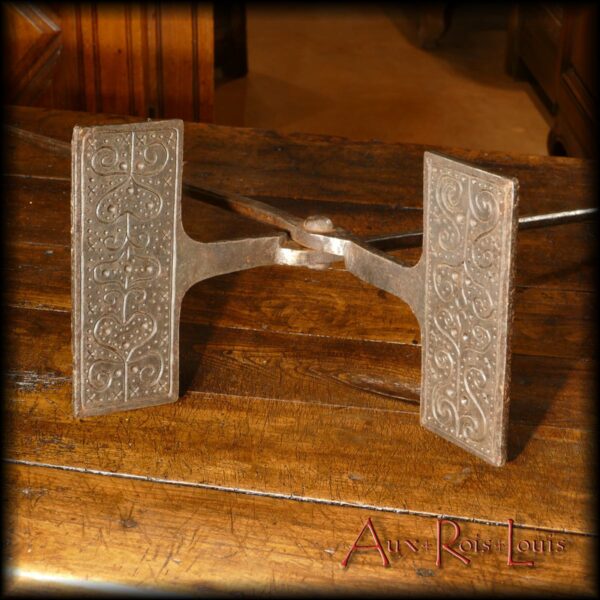Mortar and pestle in beech wood – 18th century – South-West of France – [MP039]
Mortar and pestle in beech wood – 18th century – South-West Mortar and pestle in beech wood – 18th century – South-West of France The pestle of this mortar is held with two hands, and the force exerted to crush chestnuts, for example, is increased by the nails planted on its end. Dimensions: Height: 67…


![Walnut drop-leaf writing desk – 18th century – Périgord – [ME090] Drop-leaf secretary made in Périgord in the 18th century in beautiful walnut boards. It is composed of a crossbow chest of drawers with two large drawers, surmounted by a sloping flap that opens to become a writing desk.](https://www.aux-rois-louis.com/wp-content/uploads/2022/12/ME090_P1660457b-600x600.webp)
![Walnut community table – 19th century – South West of France – [ME088] Large walnut community table from a monastery in the South West of France. It is three meters long and can easily accommodate a dozen guests.](https://www.aux-rois-louis.com/wp-content/uploads/2022/12/ME088_P1660439-600x600.webp)
![Kettle, pie dish and decaliter jug in red copper – 18ᵉ century – South West – [MP035] [MP036] [MP037] Three copper containers of exceptional size: an enormous kettle, the matching pie dish and an equally imposing pitcher. All are in red copper and date from the 18th century, a period during which they were manufactured using the same processes in the South West of France.](https://www.aux-rois-louis.com/wp-content/uploads/2022/10/ME035-036-037_426-600x600.webp)
![Mélard in White Clay and Suspended Mélard – [PA073] [PA074] – 18th century – Cantal Two walnut oil jugs, fuel used in the 18th century for lighting. The mélard on the left is in raw white clay on which concretions come from the interior. The mélard on the left benefited from a water-green glaze which made it waterproof. Its two handles allow it to be hung on a rope to be able to lean it and thus facilitate the flow of oil.](https://www.aux-rois-louis.com/wp-content/uploads/2022/10/PA073_PA074_P1660311-600x600.webp)
![Chest of Maison Forte in blond walnut – 17th century – Périgord – [ME078] Chest in blond walnut from the 17th century, from a Maison Forte du Périgord. It is decorated with a succession of eight projecting double tables or "chocolate plates", a typical Louis XIII motif. These motifs carved in the mass are two in number on each side and four on the front.](https://www.aux-rois-louis.com/wp-content/uploads/2022/09/ME078_P1660152-600x600.webp)
![Country chest of drawers in cherry wood – 18ᵗʰ century – Périgord – [ME080] Chest of drawers in cherry wood with four drawers on its curved front, two large at the bottom and two smaller at the top placed side by side. It was made in Périgord in the 18th century in thick cherry boards and rests on two scrolled legs at the front and two straight legs at the back.](https://www.aux-rois-louis.com/wp-content/uploads/2022/09/ME080_P1660186-600x600.webp)
![Chest of Knight in walnut – 18ᵗʰ century – Périgord – [ME081] Large walnut chest with straight lines ordered and shaped in the County of Périgord in the 18th century. This geographical origin is attested by a typically Périgord motif of an inverted V which houses the keyhole. The ironwork, lock, hinges and handles are all original.](https://www.aux-rois-louis.com/wp-content/uploads/2022/08/ME081_253-600x600.webp)
![Small two-piece walnut sideboard – 18ᵗʰ century – South West France – [ME073] Small two-piece sideboard made in the 18th century in the South West of France. It has a cornice, a picture rail and two largely molded drawers, four doors decorated with diamond points and it rests on two straight feet at the back and two onion feet at the front.](https://www.aux-rois-louis.com/wp-content/uploads/2022/08/ME073_P1660102n-600x600.webp)
![Walnut bonnetière – Louis XIV – 17ᵗʰ century – Périgord – [ME082] Walnut bonnetière – Louis XIV – 17ᵗʰ century – Périgord – [ME082]](https://www.aux-rois-louis.com/wp-content/uploads/2022/08/ME082_P1660256-600x600.webp)
![Oak farm table – 18ᵗʰ century – Cantal – [MP031] Oak farm table – 18ᵗʰ century – Cantal – [MP031]](https://www.aux-rois-louis.com/wp-content/uploads/2022/08/MP031_093-600x600.webp)
![Winemaker’s table in oak and poplar – 19ᵗʰ century – Champagne – [MP034] Winemaker's table in oak and poplar – 19ᵗʰ century – Champagne – [MP034]](https://www.aux-rois-louis.com/wp-content/uploads/2022/07/MP034_P1660234-600x600.webp)
![Louis XV Mirror Gilded Wood Louis XV mirror – gilded wood – 18ᵗʰ century – South West – [ME085]](https://www.aux-rois-louis.com/wp-content/uploads/2022/06/ME085_P1660289-600x600.webp)
![Large Louis XV mirror gilded wood frame Large Louis XV mirror – gilded wood – late 18ᵗʰ century – Midi-Pyrénées – [ME084]](https://www.aux-rois-louis.com/wp-content/uploads/2022/06/ME084_P1660282-600x600.webp)
![Louis XV mirror with giltwood frame Louis XV mirror – giltwood frame – late 18ᵗʰ century – South of France – [ME083]](https://www.aux-rois-louis.com/wp-content/uploads/2022/06/ME083_P1660268-600x600.webp)
![Desk table in oak and chestnut – Louis XIII – 17th century – Quercy – [ME074] This desk table was probably the prerogative of a high dignitary of the Customs corps, in charge of a flourishing trading post located on the banks of the Olt, the former name of the Lot.](https://www.aux-rois-louis.com/wp-content/uploads/2022/06/ME074_116-600x600.jpg)

![Small vat in cast iron for the soup Small vat for the soup in cast iron – 17ᵗʰ century – Fonderies du Périgord – [ME077]](https://www.aux-rois-louis.com/wp-content/uploads/2022/05/ME077_P1660136-600x600.jpg)
![Large cast iron vat for laundry Large cast iron vat for laundry – 16ᵗʰ century – Fonderies du Périgord – [ME076]](https://www.aux-rois-louis.com/wp-content/uploads/2022/05/ME076_P1660128-600x600.jpg)
![Sugar boiler for the Colonies – 16ᵗʰ century – Fonderies du Périgord – [ME075] Sugar boiler for the Colonies – 16ᵗʰ century – Fonderies du Périgord – [ME075]](https://www.aux-rois-louis.com/wp-content/uploads/2022/05/ME075_135-600x600.jpg)
![ME079_P1660184det Cast iron fireback – Louis XV – 18ᵗʰ century – South-West – [ME079]](https://www.aux-rois-louis.com/wp-content/uploads/2022/04/ME079_P1660184det-600x600.jpg)
![Imperial oil jug – 19ᵗʰ century – Quercy – [PA072]](https://www.aux-rois-louis.com/wp-content/uploads/2022/04/PA072_P1660219x1200-600x600.jpg)
![Walnut sideboard – 18ᵗʰ century – South-West – [MP030]](https://www.aux-rois-louis.com/wp-content/uploads/2022/04/MP030_740-600x600.jpg)
![Louis XIII credenza in walnut – 17ᵗʰ century – South-West – [ME071]](https://www.aux-rois-louis.com/wp-content/uploads/2022/03/ME071_P1650727x900-600x600.jpg)
![Oak wedding chest – 18th century – Auvergne – [MP028]](https://www.aux-rois-louis.com/wp-content/uploads/2022/03/MP028_705x900-600x600.jpg)
![Salt chest armchair – chestnut - cherry - poplar – 19th century – Quercy – [MP029]](https://www.aux-rois-louis.com/wp-content/uploads/2022/03/MP029_733-600x600.jpg)

![Terracotta ham pot – 19th century – Charente – [PA067]](https://www.aux-rois-louis.com/wp-content/uploads/2022/02/PA067_715-600x600.jpg)
![Folk art chestnut chest – 18th century – Béarn – [MP027]](https://www.aux-rois-louis.com/wp-content/uploads/2022/02/MP027_689x800-600x600.jpg)
![Three terracotta melards – orange, green and yellow – 19th century – Puy-de-Dôme – [PA064 PA065 PA066]](https://www.aux-rois-louis.com/wp-content/uploads/2022/01/PA064_65_66_673-600x600.jpg)
![Sideboard chest – Louis XV – 18ᵗʰ century – South West France - [ME070]](https://www.aux-rois-louis.com/wp-content/uploads/2021/12/ME070_P1650586x900-600x600.jpg)